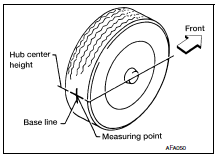Nissan Sentra Service Manual: Wheel alignment
Inspection
PRELIMINARY INSPECTION
WARNING:
Always adjust the wheel alignment with the vehicle on a flat surface.
NOTE:
If the wheel alignment is out of specification, inspect and replace any damaged or worn rear suspension parts before making any adjustments.
- Check and adjust the wheel alignment with the vehicle under unladen conditions. “Unladen conditions” means that the fuel, engine coolant, and lubricants are full; the spare tire, jack, hand tools and mats are in designated positions.
- Check the tires for incorrect air pressure and excessive wear.
- Check the wheels for run out and damage. Refer to WT-46, "Inspection".
- Check the wheel bearing axial end play. Refer to FAX-6, "Inspection".
- Check the shock absorbers for leaks or damage
- Check each mounting point of the suspension components for any excessive looseness or damage.
- Check each link, arm, and the suspension member for any damage.
- Check the vehicle height. Refer to FSU-23, "Wheelarch Height (Unladen*)".
GENERAL INFORMATION AND RECOMMENDATIONS
- A Four-Wheel Thrust Alignment should be performed
- This type of alignment is recommended for any NISSAN vehicle.
- The four-wheel “thrust” process helps ensure that the vehicle is properly aligned and the steering wheel is centered.
- The alignment machine itself should be capable of accepting any NISSAN vehicle.
- The alignment machine should be checked to ensure that it is level.
- Make sure the alignment machine is properly calibrated.
- Your alignment machine should be regularly calibrated in order to give correct information
- Check with the manufacturer of your specific alignment machine for their recommended Service/Calibration Schedule.
THE ALIGNMENT PROCESS
IMPORTANT:
Use only the alignment specifications listed in this Service Manual. Refer to FSU-23, "Wheel Alignment (Unladen*1)".
When displaying the alignment settings, many alignment machines use “indicators”: (Green/red, plus or minus, Go/No Go). Do NOT use these indicators.
- The alignment specifications programmed into your alignment machine that operate these indicators may not be correct.
- This may result in an ERROR.
Most camera-type alignment machines are equipped with both "Rolling Compensation" method and optional "Jacking Compensation" method to "compensate" the alignment targets or head units.
"Rolling Compensation" is the preferred method.
- If using the "Rolling Compensation" method, after installing the alignment targets or head units, push or pull on the rear wheel to move the vehicle. Do not push or pull the vehicle body.
- If using the "Jacking Compensation" method, after installing the alignment targets or head units, raise the vehicle and rotate the wheels 1/2 turn both ways.
NOTE:
Do not use the "rolling Compensation" method if you are using sensor-type alignment equipment.
- Follow all instructions for the alignment machine you're using for more information.
CAMBER, CASTER AND KINGPIN INCLINATION ANGLES INSPECTION
- Camber, caster, kingpin inclination angles cannot be adjusted.
- Before inspection, set the front wheels onto a turning radius gauge. Set the rear wheels onto a pad that has the same height so the vehicle will remain horizontal.
TOTAL TOE-IN INSPECTION
Measure the total toe-in using the following procedure.
WARNING:
- Always perform the following procedure on a flat surface.
- Make sure that no person is in front of vehicle before pushing it.
- Bounce the front of vehicle up and down to stabilize the vehicle height (posture).
- Push on the rear wheel to move the vehicle straight ahead about 5 m (16 ft).
- Put a mark on base line of the tread (rear side) of both tires at the same height of hub center. These are measuring points.

- Measure the distance (A) from the rear side.
- Push on the rear wheel to move the vehicle slowly ahead and to rotate the wheels 180 degrees (1/2 turn).
CAUTION:
If the wheels have rotated more than 180 degrees (1/2 turn), try the above procedure again from the beginning. Do not push vehicle backward.
- Measure the distance (B) from the front side.

- Use the formula below to calculate total toe-in.
Total toe-in : A - B
Total toe-in specification : Refer to FSU-23, "Wheel Alignment (Unladen*1)".
- If the total toe-in is outside the specification, adjust the total toe-in. Refer to FSU-7, "Adjustment".
Adjustment
TOTAL TOE-IN
Loosen the steering outer socket. Adjust the length using the steering inner socket.
Toe-in : Refer to FSU-23, "Wheel Alignment (Unladen* 1)".
CAUTION:
- Always evenly adjust both toe-in alternately and adjust the difference between the left and right to the standard.
- Always hold the steering inner socket when tightening the steering outer socket.
 Front suspension assembly
Front suspension assembly
Inspection
COMPONENT PART
Check the mounting conditions (looseness, backlash) of each component. Verify
the component conditions
(wear, damage) are normal.
Ball Joint Axial End Play
Set the ...
Other materials:
NISSAN vehicle immobilizer system (if so equipped)
The NISSAN Vehicle Immobilizer System will not
allow the engine to start without the use of a
registered key.
If the engine fails to start using a registered key
(for example, when interference is caused by
another registered key, an automated toll road
device or automatic payment device on ...
Engine oil
Inspection
Engine oil level
Note:
Before starting engine, put vehicle horizontally and check the engine oil
level. If engine is already started, stop
it and allow 10 minutes before checking.
Pull out oil level gauge and wipe it clean.
Insert oil level gauge and check that the engine oil ...
Symptom diagnosis
Push-button ignition switch does not operate
Description
Check that vehicle is under the condition shown in “Conditions of vehicle”
before starting diagnosis, and check
each symptom.
Note:
The engine start function, door lock function, power distribution system,
and nats-ivis/nvis ...

